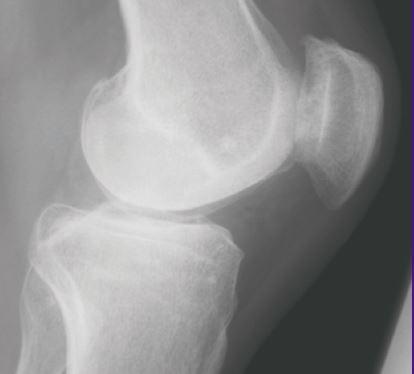New therapeutic targets for osteoarthritis pain

This is a lateral view of a left osteoarthritic knee. Credit: David A. Walsh and Joanne Stocks
It covers the limitations of existing treatments and introduces the latest understanding of the complex mechanisms behind OA pain, which offers exciting new possibilities and potential new treatment targets.
Recent patents registered suggest that areas of future OA therapies could target inflammation, bone and cartilage; sensory nerves; tissue engineering and dietary supplements.
Two new areas of intensive research, which are discussed, are the use of combination therapies and the development of biomarkers to target effective pain treatment. Due to the multiple mechanisms of the disease, pharmacological therapies alone may not work and instead require combining with psychological and physiotherapeutic approaches.
The potential of imaging, genetic or wet biomarkers to predict pain and to stratify patients most likely to benefit from specific treatment is explored. Combining biomarkers that cross different disciplinary boundaries might increase their value in predicting treatment need or outcome.
Through increased understanding of the mechanisms that underlie OA pain, new drugs could also come from re-purposing those developed for other conditions as well as novel compounds which target pain mechanisms specific to the joint.
OA is the most common form of arthritis, yet unfortunately, the most effective treatment currently available for improving quality of life is total joint replacement.
###
About our Society and Journals
SLAS (Society for Laboratory Automation and Screening) is an international community of more than 27,000 individual scientists, engineers, researchers, technologists and others from academic, government and commercial laboratories. The SLAS mission is to be the preeminent global organization providing forums for education and information exchange and to encourage the study of, and improve the practice of life sciences discovery and technology.
SLAS DISCOVERY 2016 Impact Factor 2.444. Editor-in-Chief Robert M. Campbell, Ph.D., Eli Lilly and Company, Indianapolis, IN (USA). SLAS Discovery (Advancing Life Sciences R&D) was previously published (1996-2016) as the Journal of Biomolecular Screening (JBS).
SLAS TECHNOLOGY: 2016 Impact Factor 2.850. Editor-in-Chief Edward Kai-Hua Chow, Ph.D., National University of Singapore (Singapore). SLAS Technology (Translating Life Sciences Innovation) was previously published (1996-2016) as the Journal of Laboratory Automation (JALA).
Follow SLAS on Twitter at @SLAS_Org.
Follow SLAS on Facebook at SocietyforLaboratoryAutomationandScreening
Follow SLAS on YouTube at SLASvideo.
Follow SLAS Americas on LinkedIn at Society for Laboratory Automation and Screening (SLAS Americas)
Follow SLAS Europe on LinkedIn at Society for Laboratory Automation and Screening Europe (SLAS Europe)
Media Contact
All latest news from the category: Health and Medicine
This subject area encompasses research and studies in the field of human medicine.
Among the wide-ranging list of topics covered here are anesthesiology, anatomy, surgery, human genetics, hygiene and environmental medicine, internal medicine, neurology, pharmacology, physiology, urology and dental medicine.
Newest articles

A universal framework for spatial biology
SpatialData is a freely accessible tool to unify and integrate data from different omics technologies accounting for spatial information, which can provide holistic insights into health and disease. Biological processes…

How complex biological processes arise
A $20 million grant from the U.S. National Science Foundation (NSF) will support the establishment and operation of the National Synthesis Center for Emergence in the Molecular and Cellular Sciences (NCEMS) at…

Airborne single-photon lidar system achieves high-resolution 3D imaging
Compact, low-power system opens doors for photon-efficient drone and satellite-based environmental monitoring and mapping. Researchers have developed a compact and lightweight single-photon airborne lidar system that can acquire high-resolution 3D…





















